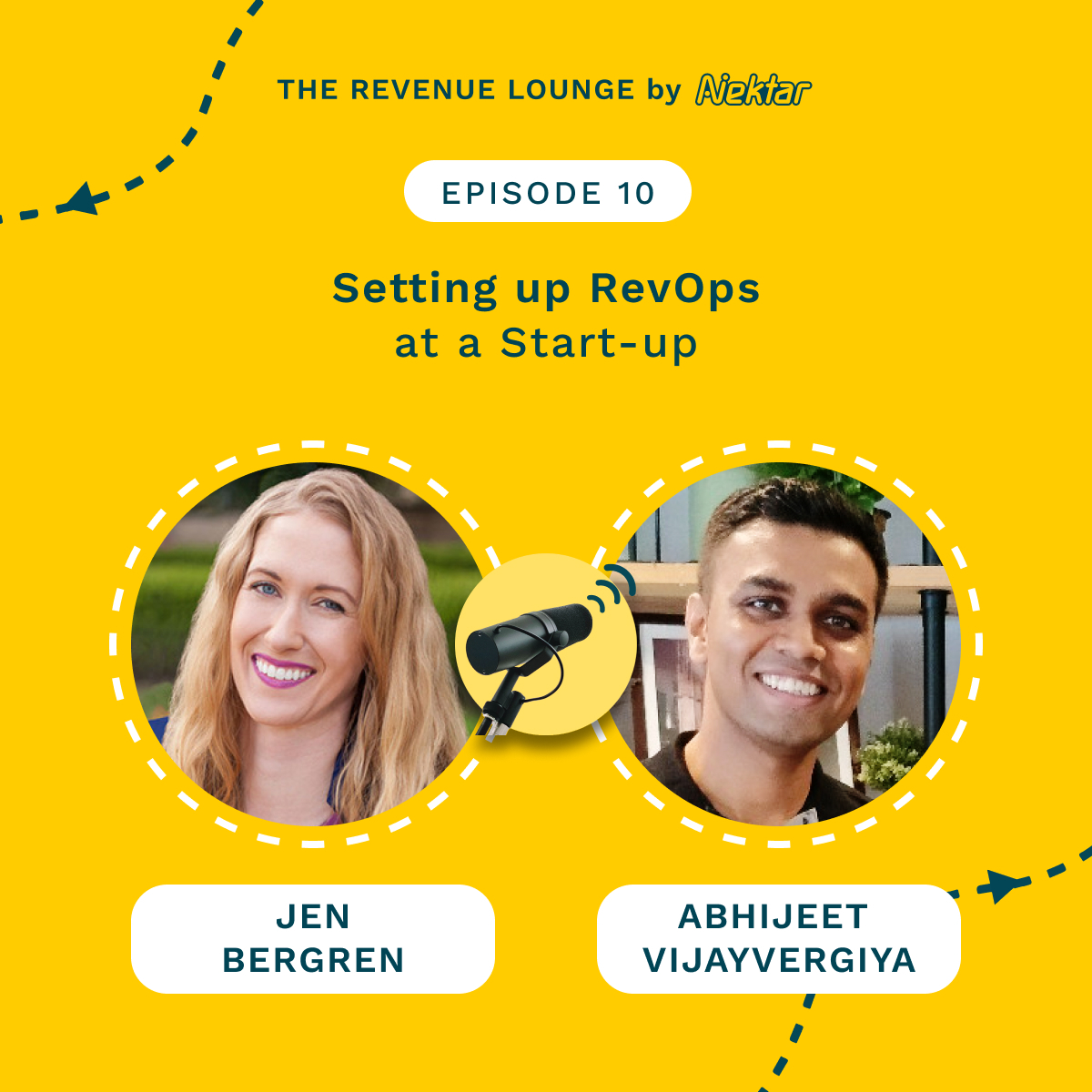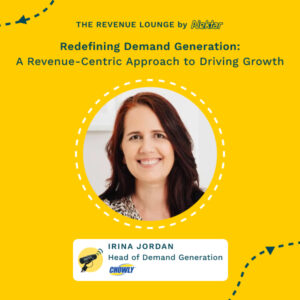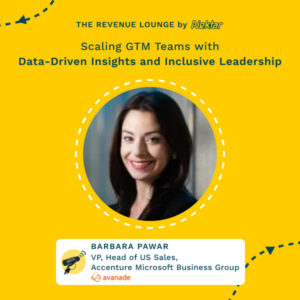Revenue Forecasting Strategies: How They Work & Evolve at Different Company Sizes ft. Keith Rabkin
July 3, 2024
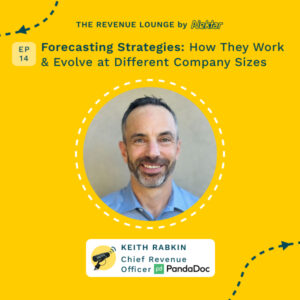
About
The Revenue Lounge
The podcast covers stories from leaders across RevOps, Sales, Customer Success, GTM, Data and Marketing about what drives these functions and what advice they would share with our listeners. With 3 seasons recorded, the podcast currently features 50+ enterprise leaders in the B2B SaaS domain. Tune in to hear from the best in the business
In this episode of the Revenue Lounge podcast, host Randy Likas interviews Keith Rabkin, Chief Revenue Officer at PandaDoc, about strategies for improving revenue operations. They discuss best practices for forecasting, reducing deal slippage, and taking a customer-centric approach. Keith shares insights from his experience leading revenue teams at large public companies as well as private companies like PandaDoc.
Guest Bio:
Keith Rabkin is the Chief Revenue Officer at PandaDoc. He has over 20 years of technology operating experience owning P&Ls and leading teams in go-to-market, product, and business operations. Keith has led teams of over 350 individuals in global roles, drove self-service sales for 400 different SaaS businesses, and helped deliver Adobe’s $9 billion digital media ARR.
Company Bio:
PandaDoc is a leading document automation software company that streamlines the process of creating, executing, and tracking documents for sales teams. It allows users to quickly configure templates, eSign documents, and analyze the engagement data on those documents to understand what’s working.
Key Quotes:
“I’d rather a deal slip 10 days and have my team not discount it and get more out of that deal than putting a time based incentive in there.” [00:03:58]
“The ability to look across all the emails, all the calls, have it piped into your CRM, and look through and see. Like, you can now pretty easily see how many stakeholders are involved on any open opportunity.” [00:20:48]
“If you respect them, you’re gonna learn more. And I think that all comes together to help you climb the career ladder, learn, get better at being in revenue.” [00:39:49]

Hello, everyone. Welcome to the Revenue Lounge podcast. I am your host, Randy Likas. And in today’s episode, we are going to unpack the complexities of forecasting and predictability. We’ll discuss the unique challenges and expectations faced by revenue leaders and explore effective strategies to reduce deal slippage and enhance predictability.
[00:00:46] Additionally, we’ll touch on the importance of customer centric approach and how it influences forecasting and revenue operations across different organizational structures. Joining me today is Keith Rabkin. Keith is the Chief Revenue Officer at PandaDoc. He has over 20 years of [00:01:00] technology operating experience, owning PNLs and leading teams in go to market.
[00:01:03] Product and business operations. Keith has led teams for over 350 individuals in global roles, drove self service sales for four different SAS businesses and helped deliver Adobe’s 9 billion digital media ARR. Keith, thanks for joining us today. Thanks for having me, Randy. Keith, you have a really interesting background coming from operations and leading different areas.
[00:01:25] I’d love to start out and talk a little bit about yourself and your background and what led you to your current role at Panda. com. Yeah, thanks. I do think I am a little bit of a non traditional CRO, but happy to talk about how I got here. I spent about 10 years at Google in a variety of strategy and ops roles and really got a handle on looking at data and using that data to guide decision making.
[00:01:46] The other thing I picked up at that time was just a relentless pursuit of making sure customers were satisfied with our product, our service. And those are things that I’ve always taken through in my career. After a while, I ended up at Adobe running [00:02:00] go to market strategy and ops for the digital media business.
[00:02:02] And it was really the first time I was completely dedicated to go to market motions. And what I saw was that those two trends of looking at data to find patterns and optimize a business and being customer centric really played well into Adobe. Taking go to market as an operation and making that go to market operation better.
[00:02:22] And so Adobe was really my first time at it, and Adobe is well known for doing this incredibly well on the PLG side and making sure that the product drives a lot of the growth, that the website drives a lot of the growth in a self service motion, but also using data to drive a great channel and self sales business.
[00:02:41] And so, That was my entry and I loved it. I loved like being obsessed with the number and seeing how changing operations could get me there. And then left Adobe to try to have more of that ownership and take on the pressure of the CRO role and have gotten that at PandaDoc. [00:03:00] So you’ve worked across large organizations, publicly traded organizations, and security scorecard, and small private organizations.
[00:03:07] How do different forecasting models differ, maybe in the way you roll up your forecast, or are held to the number at a publicly traded company versus a smaller company? Yeah, so it’s been a while since Google, and a little bit since Adobe, but they were absolute machines. When I was there, we did bottoms up forecasting like everybody else did.
[00:03:26] And Adobe is really, really good at the bottoms up. We had great models that looked at seasonality, historic rates, pulled in segmentation. We looked at different routes to market and how they performed. And then we looked at individual managers. And, you know, we use those forecasts to really hold our sales leadership together.
[00:03:45] Team to be accountable to me. The really biggest difference at a private company is that we’re not held to public quarterly targets. While our commits to the board are still really important, it’s not quite the same level of pressure. And as a CRO here, [00:04:00] I’d rather deal slip 10 days and have my team not discounted and get more out of that deal than putting a time based incentive in there.
[00:04:07] So I think the ability to play the long game is really attractive. And the other piece of it goes back to that customer centricity that we talked about. I don’t want to pressure the customer where I don’t need to. They need to be comfortable committing on a timeline that makes sense for them. Exactly.
[00:04:23] The biggest thing, I guess I would say the other big difference is, like those companies, so much of what we did was automated. Um, here at PandaDoc, we’re inspecting at this really granular level. And while it is manual, It does help us get a really good grasp on our pipeline. So that works really well at PandaDoc, looking at each deal by segment, but then also trying to go upstream and decompose how marketing is matriculating into that pipe gen, how the different partnerships are matriculating.
[00:04:52] And that gives us a lot of flexibility to in, you know, looking at it very uniquely based on the seasonality of different [00:05:00] quarters. Yeah, I love what you said there about basically sort of accommodating the customer a little bit more, right? Because Our timelines, and especially as we’re being held to maybe a public aren’t necessarily the same as the customer’s timelines.
[00:05:11] And so by listening to them and understanding and not having like end of month or end of quarter deals at the last moment, it just provides a better overall customer experience. Yeah, absolutely. I mean, how many times have you been on the other side where you’re getting pressure, right? And you may not be ready to commit.
[00:05:27] Of course you want that discount that they’re going to throw at you at the end of the cycle, but you want to buy on your own terms. Exactly. And guess what? At the end of the day, they’re going to give you that, that better price anyway, they want to get the deal done. Right. And so it does not behoove us to throw out those last quarter discounts when they don’t close because we’re going to be held to them anyways.
[00:05:43] And we couldn’t get what we wanted in the first place, which was the deal that we were on a certain timeline. Absolutely. So let’s talk about some of the best practices for creating an accurate and reliable forecast, right? Does it differ at all from maybe when you’re at a public company as opposed to the small?
[00:05:58] Or is the process still the same [00:06:00] and just maybe expectations are a little bit different? I think the process is still the same. You know, there’s deal by deal inspection, there’s using data, looking at patterns. Pipeline. So I think it’s really the same. It’s just the level of rigor and, you know, perhaps the necessity, right?
[00:06:20] If your company is publicly traded and the stock is going to swing significantly based on whether you hit the forecast or not, it’s really important to understand. That you’re going to hit it or you’re not going to hit it and make sure that you can pull any levers that you might have in your back pocket to get that forecast across the line, whether that’s a last minute discount or on a self serve business, implementing a promotion of some kind, because those public commits are just they’re so important, right?
[00:06:49] And again, not to say from a private company, we don’t take the commit seriously, but you are playing the long game. And I think that’s a really important difference. So I don’t think the [00:07:00] best practices are necessarily different. It’s just sometimes the size and the complexity of the organizations necessitates different focus areas, but I wouldn’t say they don’t.
[00:07:12] You talked a little bit about data and patterns, which is interesting. So we’ve got, you know, no shortage of data that’s available. It’s really difficult and complex to capture the right data. And I talk with a lot of revenue leaders who will say, Look, my data is not perfect. I got to make decisions off the data that I do have right now.
[00:07:31] How much of a problem is bad data when it comes to accurately forecasting and what strategies do you have in place to help make sure that you’re getting the best data possible to make these decisions? Yeah, bad data is a huge obstacle to an accurate forecast. I think most people know that if we don’t have accurate data on close rate, we don’t know.
[00:07:53] What percent of the pipeline is going to close? If we don’t have accurate data on pipeline creation, we don’t know how much pipe we’re going to have that will close. If we don’t know how [00:08:00] much closes in a quarter that hasn’t been created yet, we’re going to be inaccurate. So all of it comes together. I think it’s really important to have a strong rev ops team that puts data centricity first.
[00:08:11] I’m a big fan of making sure that the different components of rev ops, ops and mobs are partnering. Common data definitions are really important. At Adobe, we have this really interesting. concept called D DOM and we ran a weekly D DOM meeting. D DOM stands for Data Driven Operating Model, which is not maybe the best name, but it was this famous meeting at Adobe.
[00:08:34] where every week we would come together and we would look at the same sets of data across the team. And making sure that data was right was absolutely crucial because every single team in the go to market organization aligned on that data and used it to make decisions. Those decisions were not just our commits, but also what kind of levers were we going to pull to make sure that we delivered for the quarter.
[00:08:58] And again, for a very large [00:09:00] public company, it’s super important to make sure that our CFO knows exactly where we’re trending, can set expectations, can make sure they’re changing around their expense profiles, to make sure that the EPS side matches the revenue side. And so that, to me, is just super important.
[00:09:15] super crucial. We spent a lot of time over the last year in Pandadoc making sure that our RevOps team was world class and I think we’re there. We just have this amazing RevOps team that looks at data, they work really well together across team lines, and they’re increasingly partnering really well. with the sales and marketing side of the business.
[00:09:35] You probably get calls every single day from a different RevTech vendor out there trying to push their forecasting solution, you know, out there right now. They’re, you know, not necessarily looking for you to name names, but I’m curious, like, how have you leveraged different you know, RevTech tools to help you know, get the data, or help, you know, Drive more accurate forecast, either through predictive modeling or whatever it might be.
[00:09:57] God, I, I hesitate to say this ’cause I’m gonna get a lot more [00:10:00] calls, but I love taking rev Tech calls. I think they’re really interesting just to see what’s out there and understand how the different pieces fit together. I like where these tools are going, particularly in pulling in signals from calls and emails.
[00:10:13] to understand on a deal by deal basis. PandaDoc itself is a RevTech tool, and in many ways it helps us as well. We can see specifically when our prospects open up our PandaDocs. We can see what page they were on, how much time they spent on it, whether it was forwarded, and it really helps us give that deal by deal.
[00:10:33] Forecasting, you can’t look across all your documents and have it roll into your forecast yet, but it really helps me. I think the biggest thing though, besides RevTech is there’s no substitute for going back through your historic data, both from a seasonality perspective, but also an individual rep performance.
[00:10:51] Tools pull that in. But I think where the tools don’t necessarily work yet, although I think, you know, uh, hate to use [00:11:00] the AI buzzword, I think AI will help is looking at the intersection of like rep. Seasonality and deal stage. And when those things come together and you look at the intersection, you can see some really salient trends that help you get better at forecasting.
[00:11:16] For sure. Again, don’t mention vendors, but do you all use a forecasting tool today to help guide your forecast? Um, my VP of sales is pushing really hard on me to use one. My VP of CX is pushing on me to use another. So we’re looking at both and I’m kind of waiting to see how they compete head to head.
[00:11:36] Okay. So when it comes to forecasting, there’s the art and the science, right? And the science I think is the data piece of it and looking at the signals and the patterns, and then there’s the art of it, which is you got to make a call, right? In terms of what you’re feeling in the gut. So how do you think about that between what the data is saying and what you ultimately make a call on?
[00:11:57] The art to me is knowing your leaders. [00:12:00] Knowing how they make calls. Are they conservative? Are they aggressive? Who’s sandbagging? Nobody at PandaDox sandbags, but they’ll laugh at that, but I think that is a big piece of it for me. And a lot of revenue leaders do this really well. It’s pushing to get the art.
[00:12:15] So of course, when you’re running deal reviews and doing pipeline calls, you’re asking lots of questions. Do we have a true champion? And is it a real champion or is it just a coach? Who’s, you know, they’re saying the right things, but they’re not. Yeah. Unlocking the door for you. Has the rep really gone through and documented concrete next steps?
[00:12:36] Like I talked about with PandaDoc, have they opened the PandaDoc? Have they signed the paper? Have we done a really good job of discovery to understand their business needs or are there surprises lurking around the corner? Has the rep met with power? Those are the kind of questions that I like to ask a lot.
[00:12:51] And typically you get to know that certain reps do different parts of those better than others. And certain managers do a better job of holding some of those firm. [00:13:00] And so their commits can be relied on. That to me is the art. It’s sort of like knowing the people, knowing the process, and to the extent you’re involved in some of the larger deals yourself.
[00:13:11] Knowing and reading the room, there are some where, you know, you’ll look at it and you’re like the reps being completely optimistic. And I don’t believe that. And I’m going to push it out into the next quarter for my roll up to the board. Yeah. So there’s some, you know, the operating cadence, I think a lot of organizations follow and be curious to ask you what yours is.
[00:13:28] The individual reps will do their forecast to the frontline manager. That frontline manager will then do their analysis. roll it up to like their next leader and ultimately it gets up to you and you probably do a bit of hedging on that as well. Is that typically how it works for you guys as well? Yeah, it does.
[00:13:44] I really like to make it collaborative with my leaders and the layer beneath them. So we have lots of discussions. We have them every Monday looking at where we stand from the previous week, what we still have outstanding and we try to come to it together. And I would say it’s a very collaborative [00:14:00] process, but ultimately You know, my VPs are making the call to me and then I might sway it one way or another.
[00:14:08] So, you know, most organizations today, I think PandaDoc included is kind of beyond like selling a point product, right? We’re offering a solution that has Solves many different use cases, many different sort of products that make up that, that, that platform. And oftentimes as a result of that, right, we’re, we’re, we’re getting into complex sales cycles, right?
[00:14:25] There’s multiple people involved, maybe in a specific department that we need to get aligned. If we’re trying to go across department, that opens up a whole another set of stakeholders. And getting that alignment is really difficult across those key personas. And the buying group, like I said, it’s just as complex.
[00:14:39] Like you’ve got people who are, maybe it’s a priority for one group, but not for another. Right. Right. And so trying to get that established is really important. So as you get the complexity, longer sales cycles tend to happen and it’s more difficult to forecast those things. What strategies have you found, you know, work to make sure that we’ve got that proper alignment with [00:15:00] complex deals and multiple stakeholders so that things don’t slip?
[00:15:03] It’s a great question. And it does go back a little bit to some art and some science. I think. One thing I’m a really big believer in is making sure that your stages are really firm. When I first got to Pandadoc, we had loose guidelines around what different stages meant. And we’ve tried to really lock them in on things that are concrete, no judgment calls.
[00:15:27] We know exactly what that stage gate is. And if it passes that stage gate, it moves into the next stage. That gives us a much better sense of what does that stage actually mean and At facilitating the end goal of the close one revenue. So over time, it’s been a shift and the sort of likelihood of getting through to close one by stage has shifted, but it’s made us much better at understanding the timeline, not just the percentage that it’s going to matriculate, but how long it takes between stages.
[00:15:58] So that’s really important. [00:16:00] The second is making sure you’re getting to power. I mentioned that a few minutes ago, but. Knowing that we have a true champion that we’re connected to the economic buyer is absolutely crucial. And so that’s a big one that I always try to make sure. And if my reps or managers can’t answer that question, I’m going to discount the likelihood of that deal.
[00:16:23] I think the last is, we’ve talked a couple of times in this, Podcast about being customer centric and not pushing when you push people want the easy way out They’re gonna tell you what you want to hear But if we can be really customer centric in the buying process, you’re gonna get fewer false promises fewer false signals and so to me That’s a really good one that you just don’t want to misinterpret because someone’s telling you what you want to hear I would love to get your opinion on this.
[00:16:51] So there’s a bit of a philosophical debate as I’ve had conversations with people around this question, which is, would you rather have [00:17:00] a deal that maybe went to stage three or stage four, go backwards in an earlier stage, if as part of the deal inspection process, it’s not quite there, or maybe it’s lost momentum, or would you rather say, Hey, look, it hit this gate, it hit the exit criteria, we moved it.
[00:17:16] And maybe you discount that as, You know, not necessarily going to come in, but still hold the rep accountable for the stage that it’s in. Love to hear your opinion on that. Yeah, we’ve talked about it. When we have things go back, it really messes with yield rate between stages. It messes with the forecast, but ultimately, I think it is really helpful, right?
[00:17:39] Like if you say, well, the answer is it’s not getting to stage four unless a proposal is out. In our case, like we’ve got a PandaDoc, it’s sent out, it’s been looked at and opened, and they come back and they say, look, we’re not buying, scrap this proposal, I’d rather reel it back. This is not going to stay in stage four because it’s no [00:18:00] longer a viable sell cycle, right?
[00:18:02] Or Hey, this guy you sent the PandaDoc to left and now you got a whole new buyer. This is a whole new sale cycle now. So reeling it back at more accurately reflects what is happening in that sale cycle. And thus. Does much better for the forecast. Would you rather have them closed loss that so that you’re not dealing with the issues of rolling it back and then reopening a new one and aligning it to the proper stage, or does that sort of introduce its own set of gaming the system, if you will?
[00:18:34] Yeah, I think that that’s going to introduce its own set of problems. I’d probably roll it back. You could probably argue this one both ways that I would ultimately defer to the RevOps team on this one. Okay, we talked a little about deal inspection. And so I’d be interested to learn a little bit more about what you’re doing specifically around deal inspection.
[00:18:52] Do you follow like a MedPIC type of a framework to help with the inspection? And does that differ at all by your segments? [00:19:00] Like, you know, Enterprise maybe has a little bit of a different inspection process than maybe mid market or SMB. Yeah, it does. We use a much more rigorous process for mid market and enterprise than we do for SM.
[00:19:13] But I think it’s really the same things fundamentally. You can have any acronym you want to look at things, but ultimately the list of things we talked about, getting to power, making sure the economic buyer is brought in, do you understand pain, is budget there, and Have you multi threaded? Those are the kind of questions I’m asking consistently.
[00:19:34] And I mean, almost every person I’ve talked to is like, yep, it doesn’t matter if it’s Medic, Medpick, Bant, you know, you name it. Like ultimately you’re trying to get to the same truths that correlate with the ability to get things across the line. For sure. So, you know, like reps are notorious for not capturing all of the [00:20:00] different people that come in and out of the life of a deal, right?
[00:20:03] They’ve got it in their head. They know who they’re talking to, but when it comes time to do the inspection, you’ve got like the decisions not being made by one person. But if you look at the opportunity, it’s got like one person tied to it, but there’s probably been seven, eight, 10 people involved. So is that something that you look for your frontline sales managers to vet?
[00:20:22] Or how much of it are you going in and being like, guys, this doesn’t look right. I’m just trying to understand how much do you put on the frontline sales managers to do the vetting before it gets to you? I want the frontline sales managers to do most of it, to be honest. Like I trust my team. We hire great sales managers and I want them doing most of the vetting.
[00:20:40] Having said that doesn’t mean I’m not going to check. And I think this is where red tech technology is really starting to come into its own. The ability to look across. All the emails, all the calls, have it piped into your CRM and look through and see, like, you can now pretty easily [00:21:00] see how many stakeholders are involved on any open opportunity.
[00:21:04] So it’s making it from going from forensics of like going into each artifact of the sales conversation and investigating it to almost like a, Tearaway sheet that says this deal has seven stakeholders. We’ve had three at the BP level, two at the director level and two at the IC level. Here’s what the conversations look like because the conversational AI now is so good that I can get a written summary of every single interaction.
[00:21:32] Yeah. And as a leader, now that’s suddenly digestible and that’s really powerful for me to understand how my team is performing on all the things I want them to, all the things we’ve talked about on this call. Yeah. It also makes the cadence of the forecast reviews that much more productive because you’re spending less time trying to.
[00:21:49] Figure out what’s going on and more time. Like how can we actually move the deal forward? Right. So it has come a long way and just helping make those, whatever your operating cadence is more effective to like creative in terms of how do we move the deal [00:22:00] forward as opposed to what’s going on. Right. And I know you were, you’re picking on the RevTech piece before, but seeing that consolidation in the space between cadences and CI and.
[00:22:13] And the ability to pull in with a CRM and put an LLM on it makes so much sense because now the forecast module can pick up all the information from those different sources and that becomes really interesting as sets of signals that can help determine whether a deal is likely to close or not. 100%.
[00:22:32] Let’s change gears a little bit and talk about renewal and expansion piece to the business, right? So as you’re trying to maybe sell more use cases or sell more departments. It’s really important to make sure that we don’t have the leaky bucket that our renewals are in good shape. Yet many times when you’re looking at renewals, the people that bought the software to begin with Aren’t the people at the customer service or customer success organization is talking to their weekly meetings, right?
[00:22:56] They’re talking to the people responsible for the execution, but not the [00:23:00] decisions. And so I’m curious how you all structured your CS organization. Do they own renewals? Does your AE partner with them? Does AE’s drive expansion? Like how does that work at Panadoc? So we’ve got a CX organization that is responsible for just adoption and they’re the early warning signal of anything that’s going wrong.
[00:23:22] Their sister organization is the account management team, which handles all expansion and renewal. So separate from new business, we’ve really created a separation there and the AM and CX teams partner very closely. So we’re trying to drive this really healthy. adoption with a non bias rep who can get in front of the customer, help them get to value and get them sticky.
[00:23:42] And in that process it becomes much more easy to access others in the organization because they know they’re not being sold to. So the CSMs can go reach out, make sure different teams get the training they need. understand concerns. They establish a great relationship with the product team and that makes sure we get great [00:24:00] feedback there.
[00:24:00] And then when commercial transactions need to happen, the AM is coming in and facilitating that. We do try to make sure the AM is participating in a lot of the value calls as well, but this works really nicely for us and creates almost like a human based signal of opportunity and risk from the CSMs who are getting these early signals as they interface with the customers.
[00:24:24] Does your AM organization, are they strictly responsible for driving expansion and then you’ve got a separate sort of net new AE organization responsible for, for net new clients or? Yeah. So AE’s do net new, AM’s do expansion and renewals. Got it. Do you apply the same rigor to your renewal business as far as the deal inspection and that you do with a net new client?
[00:24:47] Yeah, we do. We’re forecasting. Regularly there. Similar meeting we talked about on the new business side, but every week looking at open pipeline for expansion renewals that are coming up, we [00:25:00] tend to forecast on a lightly on a six month basis, six month upcoming renewals, and then three month upcoming renewals.
[00:25:05] What’s at risk. How can we get ahead of it? What do we want to do there? We’ve got the same stage gating. that we talked about. We asked the same questions. Have you got to power? Have you multi threaded? Do you have your champion? Anything that is over a certain size, we’re taking another look at and we’re really pushing the managers on the forecast.
[00:25:26] So fairly rigorous on that side as well. Now, you guys have a lot of customers, and it’s impossible for you to touch all of your customers, right? You probably pick and choose where you need to get yourself involved. I’m curious to understand, what are the things you look for where maybe you want to start getting involved in a conversation on a deal that’s forecasted to close, or in a commit, or whatever it might be?
[00:25:48] Yeah, typically, it’s going to be size. Or strategy. Is it particularly strategic from either a logo perspective that would be attractive for us? Is it one that could lead to [00:26:00] a partnership? So maybe it’s a smaller deal, but opens up a partnership angle for us to do a co selling program. Those are the ones I tend to get most involved on.
[00:26:09] Like I said, I’m very big on data and I love to look at data. So I look at all that, all the data. And then sometimes I’ll just get curious. And I think that’s one of the things I always look for in both leaders and sellers is do they have curiosity? And I like to think I have the same myself. So just looking at the sheet and seeing the forecast, I get curious.
[00:26:29] Sometimes you’ll see an interesting name of a company and I’m like, what does this company do? I’m going to go look at this company. And then you start thinking, Oh my God, this company can use Panda doc and all these different interesting ways. What’s the rep talk to them about? That leads me to their call, and I start listening to the call.
[00:26:43] My weekends are busy with listening to calls and looking at individual call notes, so it’s always interesting for me. But the ones that I actually get on the phone for tend to be the ones we talked about. Large, strategic, possible partnership motion, maybe [00:27:00] it’s a strategic vendor that we’re working with.
[00:27:02] Those are the ones I get involved with. You need to get access to power, and they need to bring in you to help get that access to power, and so on and so forth. So I know we’ve been talking a lot about forecasting and deal inspection. I’d be remiss though, if I didn’t ask you a little bit about top of funnel and demand generation, because it all starts for making sure that we’ve got the right KPIs in place so that when we are looking at a forecast, right, we can hit the number.
[00:27:24] And most leaders right now that I talk with are finding it so difficult to hit the top of funnel metrics, right? It’s marketing and BDR organizations are just have that tougher time to hit like their MQL goals to defeat the funnel. And. There’s a lot of talk. I was at the Forrester’s conference about a month ago, and they’re really pushing for this idea around get away from MQL altogether, right?
[00:27:45] Like MQLs, we know decisions aren’t being made by one person. So an MQL doesn’t really mean anything. What we really should start thinking about even top of funnel is identifying the key personas that we know are involved in our deals and building like a stage zero opportunity [00:28:00] where we can start having marketing and BDRs help populate the, the, the buying committee.
[00:28:05] And then when we hit a certain threshold, then we pass it over to sales for them to get. So I’m just curious, is that something that y’all are looking at? Or, or I guess the question would be how important is the MQL metric, uh, to you, uh, versus maybe identifying the buying group top of funnel. Yeah, I would say the MQL is important, but not the most important.
[00:28:24] And we moved pretty hard away from MQLs about a year ago. We still look at them and we look at them weekly. But when I say we moved far away to make sure marketing and sales were aligned, we go both teams, at least early on pipeline. We want marketing thinking about pipeline and we want sales committed to getting the pipeline because we know that the pipeline converts at a historic rate.
[00:28:48] So marketing is sourcing that pipe. But sales has to accept it. If that happens, we know the two teams are working together. We know there’s joint acceptance that this is a customer with a high likelihood of making it [00:29:00] all the way through to close one revenue. And the teams have done a really good job of working together to make sure.
[00:29:06] Number one, we’re getting a feedback loop of which marketing campaigns and which MQLs turn into pipeline. Sales is making sure that they are looking through every MQL that comes through qualifying them correctly. I don’t like to have arguments. I always tell my marketing lead, you can complain about your team all the time.
[00:29:24] You can’t complain about sales. And I tell my sales lead, you can complain about your team all the time, but you can’t complain about marketing. What’s great about both these teams is they both take on a lot of accountability. We actually just had a leadership offsite a few weeks ago when neither one would blame the other team.
[00:29:39] Right. They’re just like, I own this. I own the pipeline shortage. And then the VP of marketing was like, I own the pipeline shortage. Now we actually don’t have a pipeline shortage, but like the stretch goals that we’re trying to get to. So I think that’s been really helpful for us. But were the MQLs to get right down.
[00:29:57] to the brass tacks of your question really play a [00:30:00] role or become more useful is where you start to segment them out. So in all MQLs we know are not equal. Do you have a scoring model? Can you score those MQLs? Can you separate them by company size? And when you can look at MQLs by ICP. Again, we know for larger deals, you have a bigger buying committee, but knowing that you’ve got a really good buyer ups your chance, right?
[00:30:25] If it’s a VP of RevOps, odds are that they can access the VP of sales fairly easily. They’re going to have to access the VP of sales in the deal. And so I feel really good when I get MQLs that are tied to a VP of RevOps. Um, let’s talk a little bit about closed lost opportunities. So it’s interesting because I had a conversation with someone not too long ago and they said, we don’t really treat our closed lost, no decision opportunities, any different than we closed.
[00:30:51] any closed loss opportunity. They’re all kind of the same, right? And they said the, the important thing to do is be able to close the loop and feed marketing back with the reasons [00:31:00] and why it was closed, lost, no decision, right? Because closed, lost, no decision doesn’t mean that we can’t win it in a future point.
[00:31:05] It’s just, we don’t want the reps spending any more time on it right now, right? But that doesn’t mean that marketing can’t continue to work it. The difficulty though, is that most of those people across the buying committee Have never been tagged back to CRM. They may exist in a rev tech solution, but the rev tech solution might keep it siloed in their app.
[00:31:21] But marketing doesn’t have access to those solutions. And so marketing automation systems rely on like making sure that. The six or seven or eight people are tagged to the opportunity so that they can do their thing I’m curious like how do you all think about closed lost opportunities today and use those to reactivate pipeline?
[00:31:39] I would say we just put in place something about four or five months ago where we’re now actively nurturing the closed lost opportunities We’re not doing well. retargeting on them, but we’re doing Drip campaigns back to them Feeding the information out of the clothes lost back to marketing so that they can go after them aggressively.
[00:31:59] And then [00:32:00] we have sales check in. Like we’ve got pre scheduled tasks for our sellers to do because the seller has this relationship with the company. So it’s great to hit them with marketing, but it can be a bit impersonal. Let’s make sure we hit them and let them know. And it’s really important for us because we oftentimes see people coming in as MQLs and even pipeline a little bit early to investigate the solution, but not being ready to buy, knowing that the renewal for our competitors is like nine months down the line.
[00:32:29] And so constantly being in the loop with this customer. Keeps us top of mind and enables us to make sure we’ve got enough timeline to switch things out. I think that’s one of the banes of existence of SaaS sellers is. You know, sometimes customers don’t know when to engage. They think the sales cycle is going to be easy.
[00:32:46] They think the swap out is going to be easy. And so you engage with three months, you think it’s plenty of time. And then you’re at the finish line and you’re like, no, no, no way. Like we’re not going to have any chance to overlap these tools and I can’t do it. So I’m going back and I’m going to [00:33:00] renew, even though it’s a less good solution.
[00:33:04] This has been really helpful and insightful. I want to transition to what we call the lightning round, which is a little bit less about the operations of the business, but a little bit more about advice that you might give to other folks. So I’m going to start with one question. What’s your one book maybe that you’ve read in the recent past that’s had an impact on you that you’d maybe recommend to our listeners?
[00:33:22] So my VP of sales staff has been. Getting on me to read this book for like a year and it’s an older book. It’s called from good to great. And I read it over my vacation this summer and it was just really great to see these commonalities of companies that have made this lead from being solid companies to great.
[00:33:41] One of the concepts is just knowing what your purpose is and your core strength and optimizing and going right after that strength before you go on to something else. Like I find too often. We lose focus. And if we can stay focused, we do better. And the other thing is getting the right people on the bus.
[00:33:58] Hiring is such an important part [00:34:00] of running a great revenue organization. And like we talked about, sales methodologies can change. Buying cycles change. You go through like downturns, you go through upturns. You’ve got to have people who are adaptable and curious and making sure you get those people into your revenue organization is absolutely key.
[00:34:16] So that was another takeaway from the book that I love. You said this twice now and I want to just dig a little bit deeper on it. You like curiosity. You like to look for people. How do you look for that? What are some of the questions you ask maybe in an interview to look for people that have that?
[00:34:30] Usually, it comes out pretty easily. I tend to ask behavioral questions. Tell me about a time you did more work than a deal required. Tell me about a time when someone wouldn’t let you multithread. And in hearing those, you pick up these themes of, well, I hit this roadblock, so I started asking these questions.
[00:34:50] Or, I was really curious why they wouldn’t let me do this, so I did X. And hearing those signals lights me up, because I’m like, this person is going to dig, this person is going to keep going, they’re [00:35:00] going to ask a lot of questions, they’re going to understand, What pain the buyer has, if they’re a leader, they’re going to ask questions about why the deal is not progressing.
[00:35:08] And to me, those are really big signals of success. What’s your favorite part of being a CRO? God, that’s a hard one. Well, God, there’s so many parts. I love, I love winning. I love getting teams working together, but for me, it’s impact. That’s why I took this job. That’s why I left big companies was so I could see the impact that I was having.
[00:35:29] And that impact is not, when I say it’s not the impact I have, it’s the impact that I’m having. The teams that I’m working on building, the teams we’ve assembled, the teams that have been trained and are constantly doing all that frontline work. The impact they have, it’s the impact they have on our customers, getting them into a great solution.
[00:35:48] We like, we really love what PandaDoc does for our customers. And so seeing these customers be successful gets me really fired up. Seeing my salespeople be really successful gets me fired up. Being able to go to [00:36:00] the board and tell them that we beat plan gets me fired up. Seeing my leaders celebrate and get excited that they’re accomplishing something gets me fired up.
[00:36:08] So that’s the best part. It’s that impact and it’s customers, team, and company all together. I loved your post that you had a couple weeks ago about you were on a call with a couple of your reps and like just observing. I think the example was, They actually were honest and said, I don’t necessarily know that we’re the best solution for you at this time.
[00:36:26] Right. And you took a lot of pride in that because it’s seeing that your team cares and that your team is making the impact. And I think that’s really great. Well, your reputation stays with you forever. Right. And I would rather have that customer like really think about it and then think is the person that is selling me the best solution.
[00:36:46] Or am I actually looking for something different? If they come and they’re in a bad solution, it’s going to be terrible for my CX team. They’re going to churn. Maybe my rep gets a claw back. That’s all horrible. But if they come away knowing they had a great [00:37:00] experience, they may tell their friend, Hey, this wasn’t right for me, but this is a good solution for you.
[00:37:04] It builds so much trust. They’re not used to having a rep actually say that. Okay. What’s the flip side of that question? So what is the least favorite part of being a CRO? Sweating it out. I mean, you always want to cushion. But in this environment, it’s been tough and, you know, sweating it out. That’s hard taking a discount.
[00:37:23] We talked about that hurts on the flip side, losing a customer hurts the most. That is probably the thing that hurts me the most is we’ve got a customer, a Panda doc, they were happy with us. They’re leaving. What could I have done differently? I take every customer hit personally. So that is probably the hardest.
[00:37:41] I agree 100%. What’s one piece of advice that maybe you’ve received throughout your career that’s really stuck with you and helped you shape who you are today? I think it’s probably around giving feedback. So everybody talks about the gift of feedback. They want feedback. Everybody says, give me blunt [00:38:00] feedback.
[00:38:00] A lot of times people don’t mean it. And. I think people can be afraid to give very honest feedback because it seems mean. But if you think about how to make the feedback you’re giving absolutely factual with no interpretation, it makes it much easier to accept. And in the end, this is going to help the team get better.
[00:38:21] And when that light bulb goes off that you’re giving advice bluntly, but effectively you start getting in the habit of giving it more because you see it click. And I think that’s something that took me a while to get good at, but the more just like, let me just lay out very, very honestly, but factually, It’s not my interpretation of your performance.
[00:38:43] These are the numbers. This is the expectation. This is what was supposed to happen. And I think that’s more of course, on the like critical and development side, it’s absolutely fine to celebrate and be more emotional on the high side. I was once in a client meeting and [00:39:00] we were at risk of losing the clients and they were giving us some feedback and it was tough to hear.
[00:39:05] Right. And some of the folks on the team were getting a little defensive and the main. stakeholder said something that’s stuck with me throughout my career, which is feedback is a gift. And I didn’t quite get it at the time when they said it, but I thought about it. And it’s actually very true. Like that feedback is a gift to help improve 100%.
[00:39:25] All right, last question. So what’s one piece of advice that you might give someone either in an IC role right now or a frontline sales manager role? That would like to have your job some of the Lots of advice. But I would say probably the one thing is to work with people you respect. So number one, it’s going to make the job more fun.
[00:39:42] And in turn, it’s going to make you want to show up for them, which will drive you to be better. If you respect them, you’re going to learn more. And I think that all comes together to help you climb the career ladder, learn, get better at being in revenue. So that’s definitely my advice. Well, Keith, [00:40:00] that’s a wrap for today’s episode of The Revenue Lounge.
[00:40:02] I just want to say thank you very much for joining us today. I had a wonderful time speaking with you. Thank you so much. Appreciate it, Randy.

Ep #1: Navigating the Downturn with a Hyperfocus on Productivity
Listen Now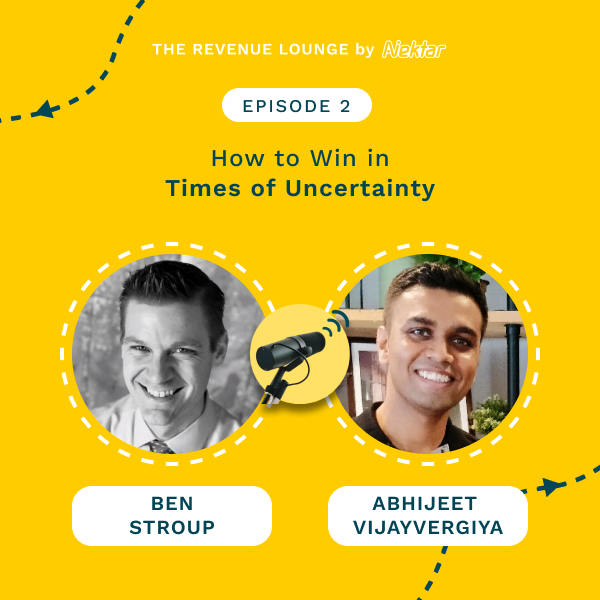
Ep #2: How to Win in Times of Uncertainty
Listen Now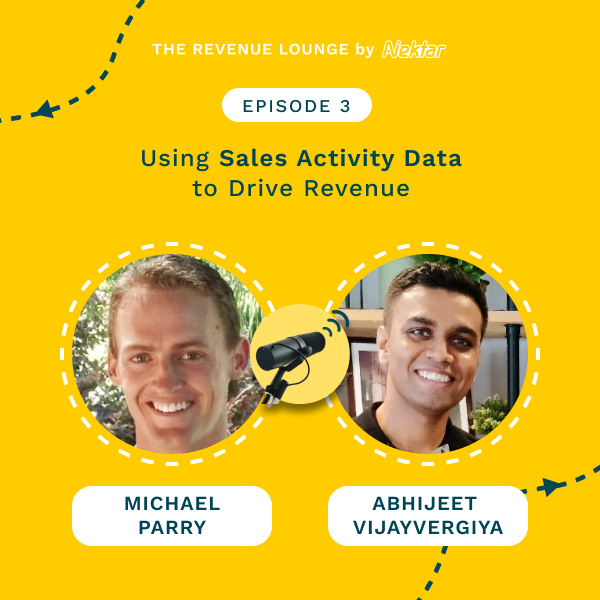
Ep #3: Using Activity Data to Drive Sales Productivity
Listen Now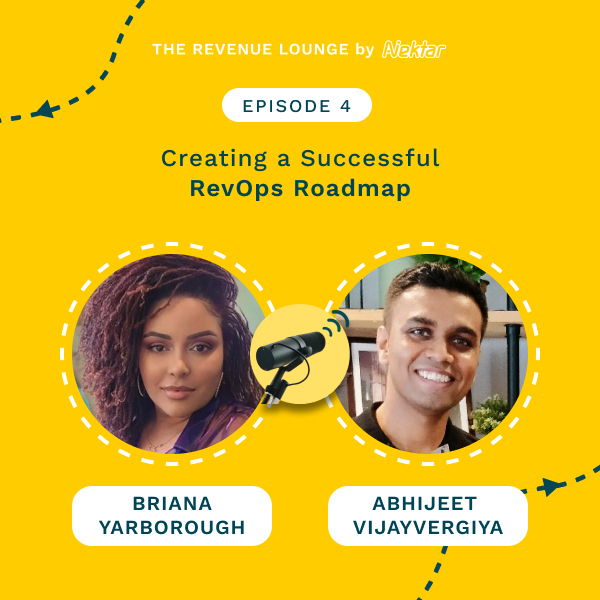
Ep #4: Creating a Successful RevOps Roadmap
Listen Now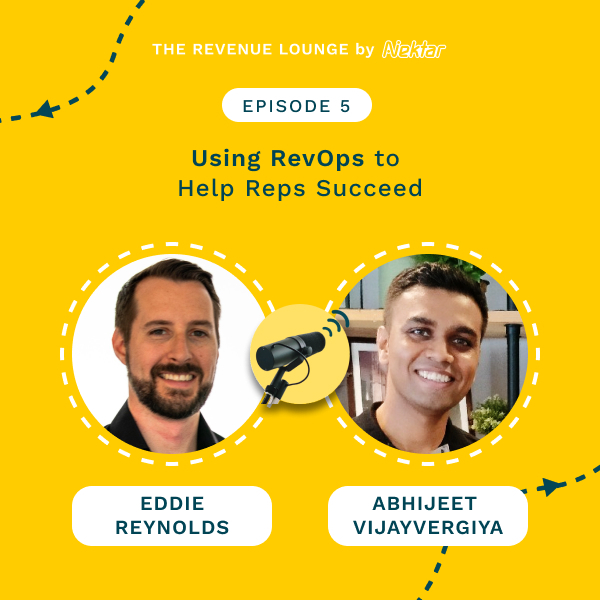
Ep #5: Using RevOps to Help Reps Succeed
Listen Now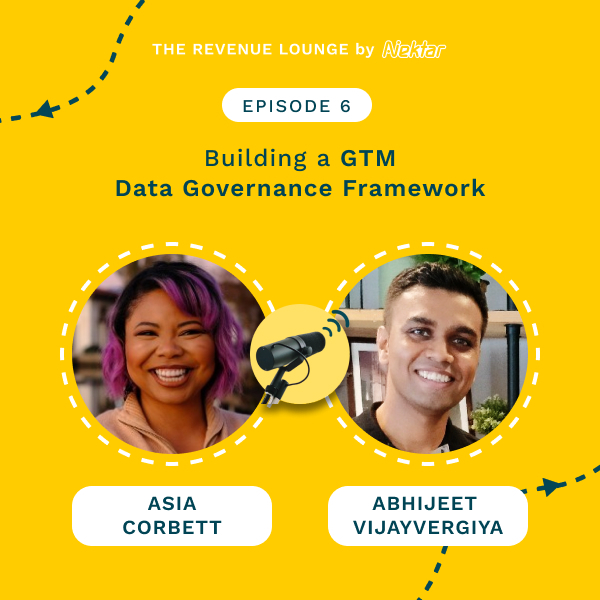
Ep #6: Building a GTM Data Governance Framework
Listen Now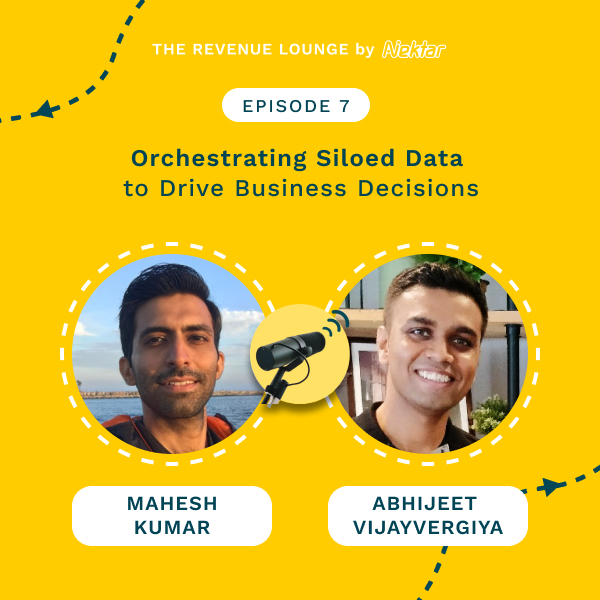
Ep #7: Orchestrating Siloed Data to Drive Business Decisions
Listen Now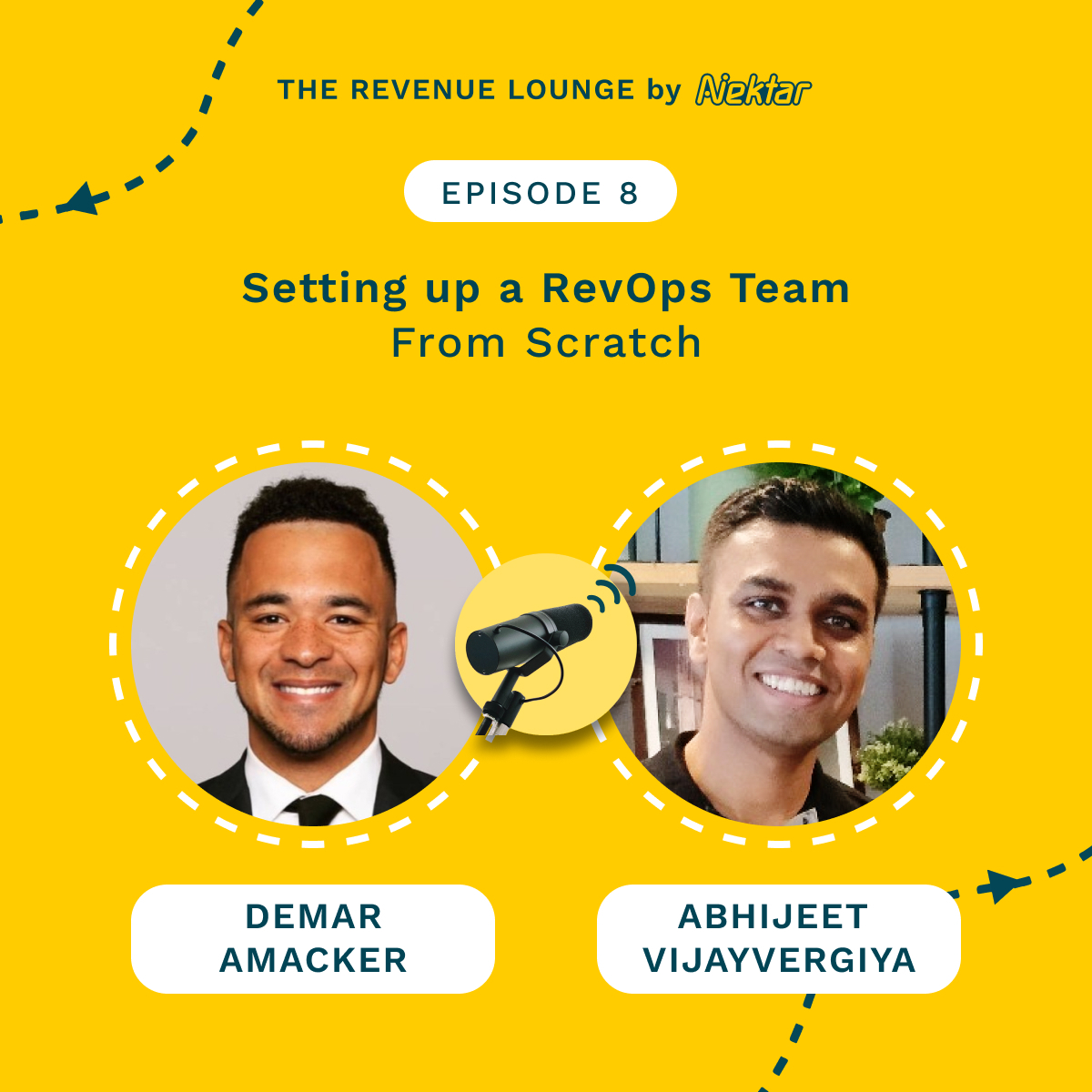
Ep #8: Setting Up a RevOps Team From Scratch
Listen Now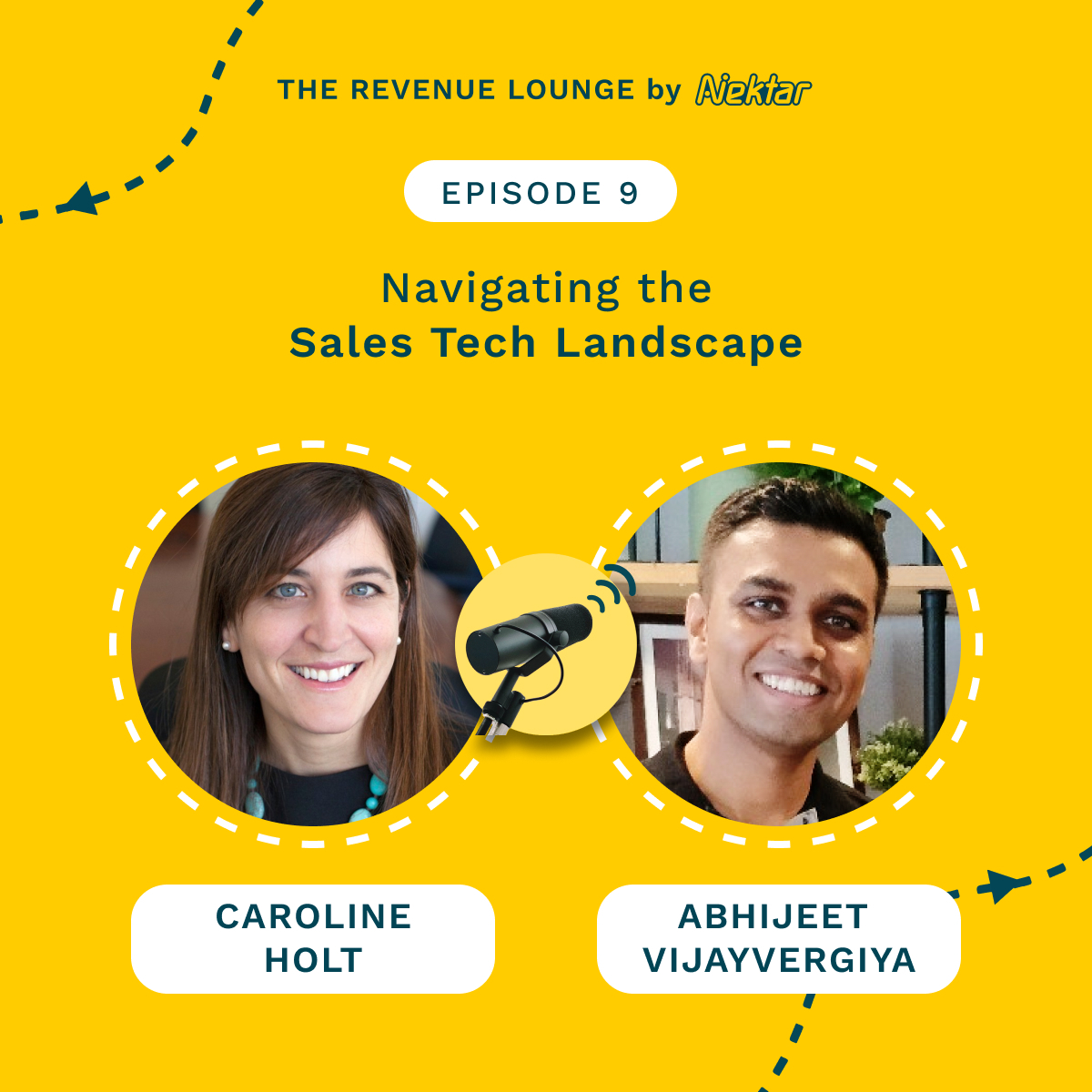
Ep #9: Navigating the Sales Tech Landscape
Listen Now